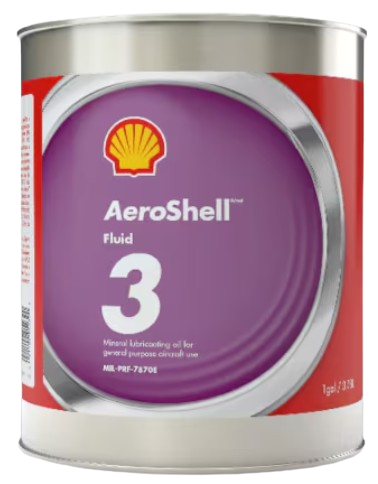AeroShell Fluid 3
Explore AeroShell Fluid 3’s capabilities as a low viscosity lubricant, perfect for general aircraft part lubrication with robust low temperature performance and oxidation resistance.

Features and benefits
Excellent Low-Temperature Performance
Corrosion & Oxidation Inhibition
Versatile Application
Low Evaporation Rate
Specifications & approvals
| Country / OEM | Specification |
|---|---|
| United States | MIL-PRF-7870E |
| British | DEF STAN 91-47 (Obsolete) |
| NATO Code | O-142 |
| Joint Service Designation | OM-12 (Obsolete) |
| Rolls-Royce | OMat1029 |
The TDS and MSDS are in English, but you can find these documents for other countries in the Shell EPC area
.
Applications
AeroShell Fluid 3 is recommended for general lubrication of aircraft parts that require a light oil, e.g. hinges, pivot joints, shaft joints, linkage pins and bearings, pulleys, cables, camera mechanisms, radio and radar gear and instruments. AeroShell Fluid 3 is normally applied by means of an oil can or brush. For this reason, it is also described as ‘an oilcan lubricant’.
Operating temperature range of AeroShell Fluid 3 is –54°C to +121°C (–65°F to 250°F).
For high temperature applications where no provision is made for frequent relubrication the synthetic oil, AeroShell Fluid 12, should be used in place of the mineral oil, AeroShell Fluid 3; however in this case care should be taken to ensure that there is no incompatibility between AeroShell Fluid 12 and seals, paints etc.
Health, Safety and Environment
Health and Safety
- This product is unlikely to present any significant health or safety hazard when properly used in the recommended application and good standards of personal hygiene are maintained.
- Avoid contact with skin. Use impervious gloves with used oil. After skin contact, wash immediately with soap and water.
- Guidance on Health and Safety is available on the appropriate Safety Data Sheet, which can be obtained from https://www.epc.shell.com/
Protect the Environment
- Take used oil to an authorised collection point. Do not discharge into drains, soil or water.
Additional information
Advice
- Advice on applications not covered here may be obtained from your Shell representative.
Get in touch with us
We’re here to assist you with any inquiries or support you may need
Typical Physical Characteristics
| Properties | Method | MIL-PRF-7870E | Typical |
|---|---|---|---|
| Oil type | – | – | Mineral |
| Colour | ASTM D1500 | 0.5 max | <0.5 |
| Density @15°C kg/m³ | ASTM D4052 | – | 890 |
| Kinematic Viscosity @38°C mm²/s | ASTM D445 | 10 min | 10 |
| Kinematic Viscosity @-40°C mm²/s | ASTM D445 | 4 000 max | <4 000 |
| Flash Point (Cleveland Open Cup), °C | ASTM D92 | 130 min | 155 |
| Pour Point °C | ASTM D5949 | -57 max | <-57 |
| Evaporation Loss 22h @99°C, %m | ASTM D972 | – | 19 |
| Total Acid Number mg KOH/g | ASTM D664 | Report | 0.68 |
| Low temperature stability 72 hrs @-54°C | FED-STD-791- 3458 | Must pass | Passes |
| Corrosion and oxidation stability 168 hrs @121°C – metal weight change | ASTM D4636 | Must pass | Passes |
| Corrosion and oxidation stability 168 hrs @121°C – viscosity change at 37.8°C, % | ASTM D4636 | -5 to +20 max | 10 |
| Corrosion and oxidation stability 168 hrs @121°C – acid number change, mgKOH/g | ASTM D4636 | 0.2 max | 0.06 |
| Precipitation number ml | ASTM D91 | 0 max | Passes |



